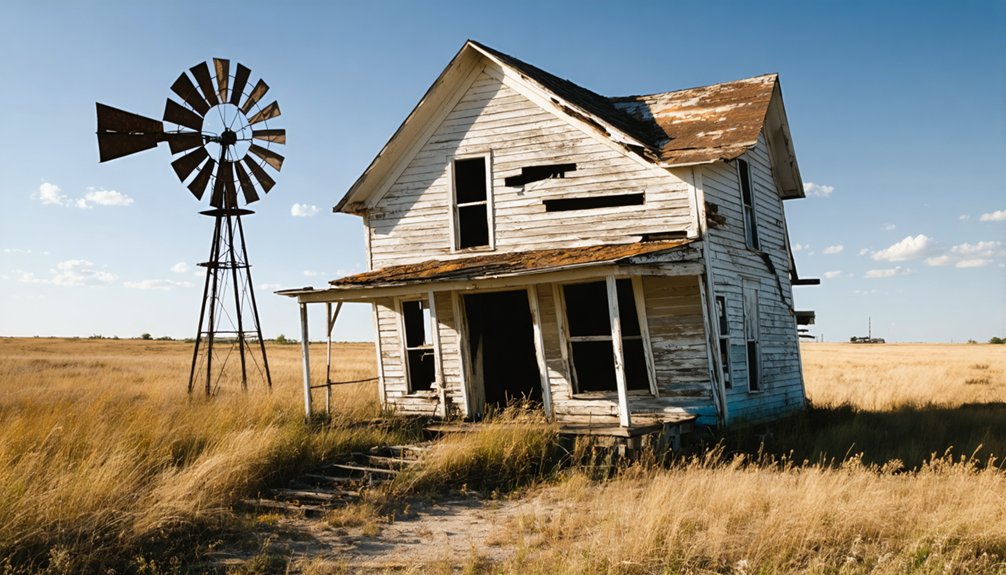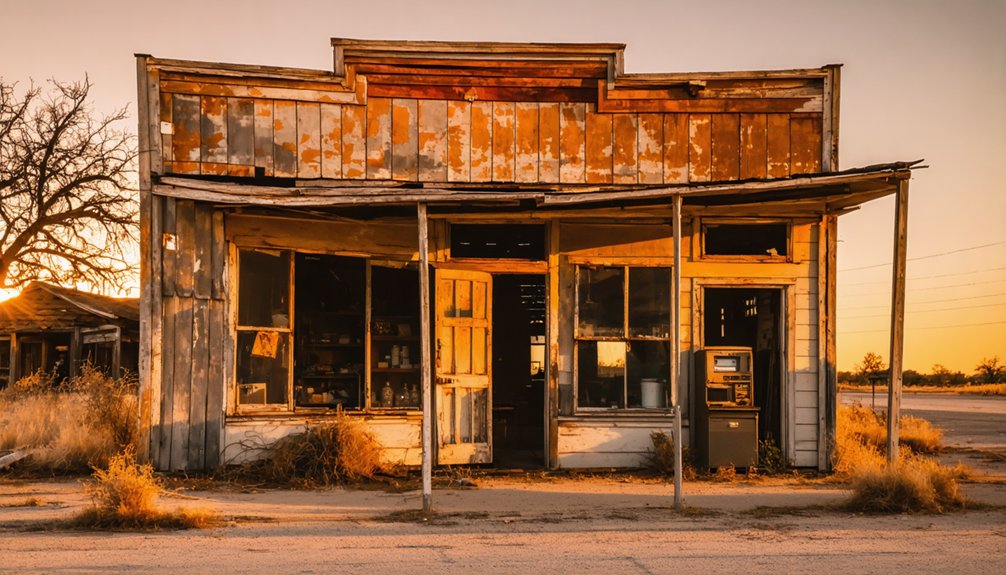You’ll find Phelan’s abandoned coal mining town just two miles north of Bastrop, Texas, where crumbling foundations and a solitary cemetery are all that remain of a once-thriving community. Established by John C. Phelan’s Independence Mining Company, the town peaked at 800 residents in 1914, producing up to 50,000 tons of lignite coal annually. While most structures have vanished, the site’s hidden remnants, including a bank vault and scattered mining equipment, tell a deeper story of Texas’s industrial past.
Key Takeaways
- Phelan was a thriving mining town in Bastrop County that peaked at 800 residents in 1914 before becoming a ghost town.
- The Independence Mining Company produced 10,000-50,000 tons of lignite coal annually until oil locomotives reduced demand.
- Only scattered foundations, mining equipment debris, and a bank vault remain at the largely inaccessible site today.
- The town cemetery, located 2 miles north of Bastrop near Farm to Market Road, is the only maintained landmark.
- Dangerous abandoned mine shafts and unstable soil make exploration hazardous, with most remnants buried beneath the surface.
The Birth of a Mining Town
When John C. Phelan founded the Independence Mining Company, he laid the groundwork for what would become one of Texas’s significant lignite coal mining communities. The town origins trace back to Bastrop County’s unique position as one of the few areas with substantial lignite deposits worth exploiting commercially.
You’ll find that Phelan’s mining beginnings transformed the area rapidly. By 1905, the settlement had grown enough to warrant its own post office, serving the needs of a burgeoning mining community. Phelan himself took charge as the town’s first local postmaster during this period.
The town’s infrastructure expanded to include a general store and, by 1910, a school for miners’ children. As operations flourished, Phelan attracted a diverse workforce, including many Mexican laborers, and the population swelled to approximately 800 residents at its peak. The mining operations came to a tragic end when twenty workers died in a devastating shaft collapse during the 1920s.
Life in Early 20th Century Phelan
As Phelan evolved into a company town in the early 1900s, its social structure reflected the typical hierarchies of American mining communities.
You’d find clear divisions between management, skilled workers, and laborers, evident in their housing arrangements and access to resources. By 1904, about 400 residents called Phelan home.
Family dynamics centered around traditional gender roles, with men working the mines while women managed households and sometimes earned extra income through boarding services. The arrival of Miles Frank Yount in 1915 brought new economic opportunities through oil development.
Cultural traditions revolved around Protestant churches and company-sponsored gatherings, while the company store dominated daily commerce. Like many Texas towns of the era, Phelan’s educational materials focused heavily on patriotic education.
You’d see children attending the local school, and miners’ families living in company-built housing clustered near the mine.
The town’s population remained largely Anglo-European, with social life organized around churches, schools, and informal sports activities.
The Coal Mining Legacy
You’ll find Phelan’s coal mining operations were centered around the Independence Mining Company, which employed significant numbers of Mexican laborers to extract the region’s valuable lignite deposits through underground shafts and adits.
The mining town reached its peak in 1914 with approximately 800 residents, supported by a general store and basic services that catered to mining families. The high-grade lignite produced at the mines was sold to railroads until oil-burning locomotives became prevalent. Similar to the Houston and Texas Central Railroad that established Elgin in 1872, the railway system played a crucial role in Phelan’s development.
The community’s tight-knit social structure revolved entirely around the coal industry, making Phelan a quintessential example of Texas company towns until its eventual decline in the 1920s and 1930s as oil replaced coal.
Mining Operations Overview
Founded in 1903 by John C. Phelan, the Independence Mining Company pioneered lignite extraction in Bastrop County, establishing one of Texas’ few commercial coal mining towns.
You’ll find this lower-grade coal operation was essential to the region’s early industrial energy supply, employing both underground and surface mining techniques as technology evolved.
The mining operation’s key features included:
- Vertical shafts and sloping adits for underground extraction until the 1930s
- Shift to surface strip mining methods after 1920, becoming exclusive by 1951
- Important infrastructure including a post office (1905) and school (1910) to support the mining community
During its peak in 1914, Phelan’s population reached 800, thriving alongside Texas’ broader coal industry expansion. The operation’s annual output typically ranged 10,000 to 50,000 tons, which was characteristic of local mines during this era.
The operation remained modest compared to northern Texas bituminous fields but served as a significant regional energy source until oil and gas gained dominance.
Employment and Social Impact
The human toll of Phelan’s coal mining operations stretched far beyond the physical extraction of lignite. Like many coal towns across America, Phelan experienced dramatic employment trends that transformed its social fabric.
You’d have seen the evolution from harsh mining camps, marked by violence and poor conditions, to established family communities with schools and entertainment venues. The early camps were often called hell holes by miners who endured terrible living conditions.
As employment peaked around 1980 with 200,000 jobs nationally, mining families enjoyed relative stability. The rise of low-sulfur western coal and railroad deregulation in the 1980s began shifting jobs away from eastern mining towns. But when EPA regulations and natural gas competition intensified after 2012, the workforce rapidly declined.
This social decline hit Phelan hard, mirroring the pattern of other mining communities where job losses triggered population exodus. What once was a thriving town with strong union presence and cultural identity eventually succumbed to the economic pressures that have turned numerous coal communities into ghost towns.
Community and Social Structure
Like many rural Texas communities of its era, Phelan maintained a close-knit social structure centered around agricultural life and family bonds.
You’d find strong community cohesion through local churches and schools, which served as essential hubs for social networks and daily interactions. The town’s residents relied heavily on mutual support and cooperation to sustain their rural lifestyle. Similar to many communities in the region that experienced population loss over 50%, residents gradually departed as economic opportunities dwindled.
Key aspects of Phelan’s social framework included:
- Churches that functioned as both spiritual centers and venues for community gatherings, record-keeping, and conflict resolution
- Schools that doubled as meeting places for social events, sports activities, and holiday celebrations
- Informal governance systems where community elders and religious leaders played significant roles in maintaining social order
These institutions helped preserve the town’s social fabric until economic changes led to its eventual decline.
The Path to Abandonment

During its peak years alongside the Texas and Pacific Railway expansion, Phelan embodied the promise of rural prosperity that attracted settlers to countless Texas towns.
Like many single-industry communities, you’d find Phelan’s fortunes directly tied to the railroad’s presence, which brought jobs, commerce, and crucial connections to the outside world.
The town’s path to abandonment followed a familiar pattern of economic decline. When rail traffic diminished and routes changed, Phelan faced increasing community isolation.
You could see the domino effect: businesses closed, younger residents moved away for work, and necessary services shut down. Weather and time took their toll on empty buildings, leaving only scattered ruins and foundations.
Exploring the Ghost Town Today
You’ll find Phelan’s site largely inaccessible today, with no standing structures remaining and dangerous abandoned mine shafts dotting the private property.
The only visible remnants are scattered foundations, buried artifacts including the town’s bank vault, and various coal mining equipment debris spread across the grounds.
Due to safety concerns and private property restrictions, you’ll need explicit landowner permission to legally explore the site, though documentation suggests no formal visits have occurred since 1991.
Accessible Cemetery Remains Standing
While many remnants of Phelan’s mining past have vanished, the town’s cemetery stands as its sole surviving landmark, located approximately 2 miles north of Bastrop near the intersection of Farm to Market Road in Bastrop County, Texas.
The site’s historical significance lies in its connection to the area’s once-thriving lignite mining community, while cemetery preservation efforts have kept the grounds accessible and maintained.
If you’re planning to visit this piece of Texas history, you’ll find:
- Clear access from Highway 71 to Highway 95 North between Bastrop and Elgin
- Visible gravestones in an open, maintained area without significant deterioration
- Geographic coordinates (30° 09′ 14.47″ N, 97° 19′ 57.94″ W) to guide your journey
The cemetery remains a reflection of the region’s mining heritage, though you won’t find formal amenities at this primitive historical site.
Hidden Foundations Below Ground
Beneath the Texas soil of Phelan’s ghost town lie the hidden remnants of a once-thriving mining community, including building foundations and the town’s original bank vault.
You’ll find these underground secrets scattered across private property, telling a hidden history of early 20th-century coal mining operations.
While you might be tempted to explore these subterranean structures, it’s important to recognize the dangerous conditions that exist.
The unstable Texas soil, combined with numerous abandoned mine shafts, creates significant hazards for anyone venturing into the area.
The foundations and vault remain largely inaccessible due to private property restrictions and safety concerns.
Local records in Bastrop County can provide detailed information about these underground features, though physical exploration isn’t recommended due to the risks involved.
Current Structures And Ruins
Due to the lack of historical documentation, the current state of Phelan’s structures and ruins remains uncertain.
Like many Texas ghost towns, potential discoveries could reveal foundations, building remnants, or other historical artifacts beneath the surface. The current conditions of any existing structures can’t be verified without thorough investigation, similar to documented ghost towns like Terlingua or Lobo.
- You’ll find that ghost towns across Texas often share similar patterns of structural decay, where buildings slowly return to the earth.
- If you’re exploring Phelan, expect conditions typical of abandoned Texas settlements, where weather and time have taken their toll.
- You might encounter traces of previous settlement patterns that mirror those found in other ghost towns throughout the state.
Frequently Asked Questions
What Happened to the Mining Equipment and Machinery After the Town’s Abandonment?
You’ll find that most mining equipment was abandoned on-site, with locals scavenging valuable parts. What wasn’t taken deteriorated from exposure, while some pieces became historical artifacts in the ghost town.
Are There Any Surviving Descendants of Phelan’s Original Residents Still Living Nearby?
Like scattered seeds from an old oak tree, you’ll find descendants through local descendant interviews and family reunions, though you’ll need extensive genealogical research to verify direct lineage connections in Bastrop County.
Did Any Other Industries Attempt to Establish Themselves in Phelan?
You won’t find evidence of other industries taking root in this company mining town. Despite opportunities for railroad expansion or agricultural efforts, Phelan remained strictly focused on lignite coal extraction.
What Was the Peak Population of Phelan During Its Most Prosperous Years?
In its heyday, you’d find 800 residents living in this bustling mining community at its peak prosperity around 1914, though population decline hit hard afterward, dropping to just 200 by 1925.
Were There Any Notable Accidents or Disasters in the Phelan Mines?
Historical investigations haven’t uncovered any documented major accidents in these mines. While mine safety was likely a concern, you won’t find records of notable disasters during their operation.
References
- https://www.geotab.com/ghost-towns/
- https://discovertexasoutdoors.com/places/phelan/
- https://commons.wikimedia.org/wiki/File:Phelan_Cemetery
- https://en.wikipedia.org/wiki/List_of_ghost_towns_in_Texas
- https://www.ghosttowns.com/states/tx/phelan.html
- https://www.tshaonline.org/handbook/entries/phelan-tx
- https://kutkutx.studio/texas-standard/diving-into-texas-history/?numpage=23
- https://texashighways.com/culture/history/century-old-image-captures-a-bastrop-county-mining-band/
- https://en.wikipedia.org/wiki/Phelan
- https://discovertexasoutdoors.com/places/phelan-texas-exploring-the-historic-ghost-town-of-bastrop-countys-coal-country/



